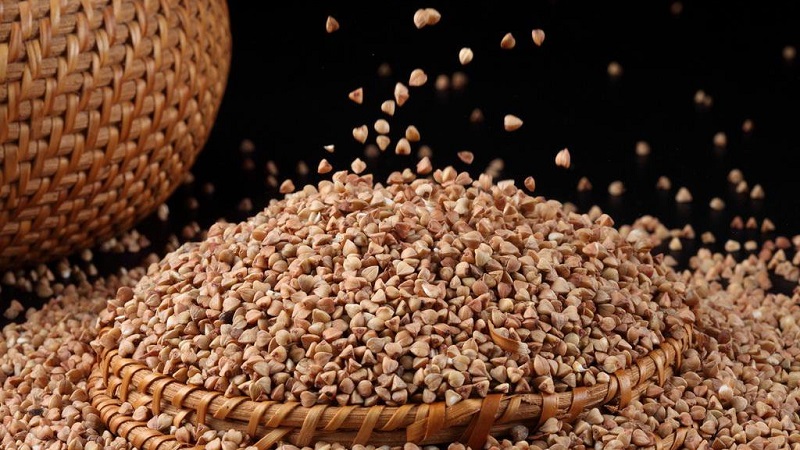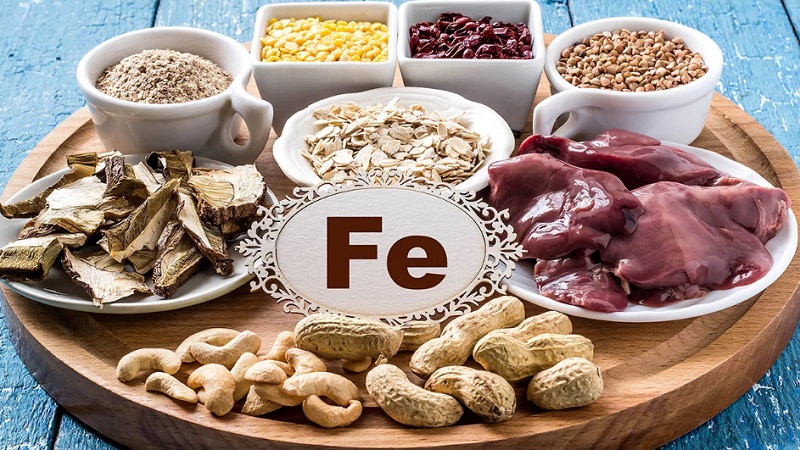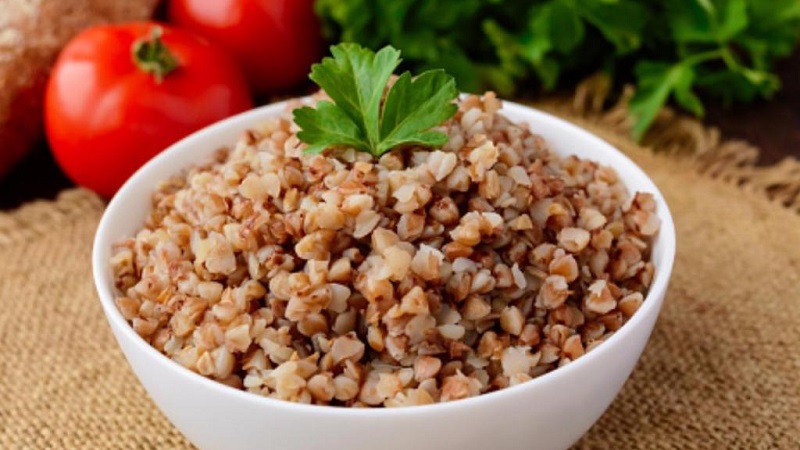How much iron is in buckwheat and how well it is absorbed
Buckwheat has a high content of iron - one of the key components in the formation of red blood cells. Iron deficiency can lead to anemia. Compared to other grains, the minerals in boiled buckwheat are particularly well absorbed.
The article will tell you about the composition of buckwheat, the role of iron in the human body and how to eat this buckwheat so that all trace elements from it are absorbed as fully as possible.
The content of the article
Chemical composition, nutritional value, microelements and vitamins of buckwheat
Carbohydrates are the main component of buckwheat... Protein and various minerals and antioxidants are also present. Some of the soluble carbohydrates in buckwheat, such as phagopyritol and chiro-inositol, lower post-meal blood sugar.

Buckwheat composition:
- Cellulose... Buckwheat contains a decent amount of fiber. This ingredient is beneficial for colon health. By weight, fiber makes up 2.7% of cooked cereals and mainly consists of cellulose and lignin. Buckwheat is rich in insoluble fiber, which means it significantly reduces the chances of gallstones forming.
- Protein... Buckwheat contains a small amount of protein. By weight, protein makes up 3.4% of boiled buckwheat. Thanks to the well-balanced amino acid profile, the protein in buckwheat is of the highest quality. However, the absorption of these proteins is relatively low due to antinutrients such as protease inhibitors and tannins. Like other pseudo-cereals, buckwheat is gluten-free and therefore suitable for people with gluten intolerance.
- Vitamins and minerals... Buckwheat contains more minerals than many common grains such as rice, wheat and corn. Buckwheat is rich in vitamins that support the functioning of the immune, nervous and hematopoietic systems, have a beneficial effect on the digestion process, promote weight loss, namely: retinol, tocopherol, thiamine, riboflavin, pyridoxine, folic acid, niacin, beta-carotene. Minerals contained in buckwheat: manganese, copper, magnesium, iron, phosphorus.
- Other plant compounds... Buckwheat is rich in plant antioxidants: rutin, quercetin, vitexin, chiroinositol. These are soluble carbohydrates that lower blood sugar levels and help treat diabetes. One of the most important qualities of buckwheat is its high level of phytonutrients, in particular flavonoids. These important compounds eliminate dangerous free radicals, a byproduct of cellular metabolism that causes heart disease and other conditions.
The nutritional value of buckwheat is significantly higher than many other cereals:
| The basis | The nutritional value |
|---|---|
| Calories | 343 kcal |
| Carbohydrates | 71.50 g |
| Protein | 13.25 g |
| Fats | 3.40 g |
| Cellulose | 10 g |
| Alimentary fiber | 11,3 g |
| Water | 14 g |
Reference! Properly cooked porridge combined with protein or fiber helps lose weight.
The role of iron in the human body
Iron helps to form and oxygenate blood cells... One of the most important functions of a trace element is the synthesis of heme, which forms hemoglobin, a protein found in red blood cells.

The main role of hemoglobin is transporting oxygen from the lungs to body tissues to maintain basic vital functions.Without healthy red blood cells, your body won't get enough oxygen.
Besides, iron contributes to full cognitive function and has a positive effect on memory, attention (concentration), learning, intelligence, communication.
The amount of iron a person should take on a daily basis depends on age and gender... Women need more than men. Men over the age of 18 need 8 mg per day. Women - 18 mg per day until age 50 and 27 mg per day during pregnancy. Women over 50 require the same amount of iron as men.
Lack of iron known as iron deficiency anemia, in which red blood cells in the human body tend to decrease in number.
Missing element signs:
- increased fatigue;
- weakness;
- pale skin;
- chest pain, rapid heartbeat, or shortness of breath;
- headache, dizziness;
- cold hands and feet;
- inflammation or soreness of the tongue;
- brittle nails;
- poor appetite.
Iron deficiency can cause complications regardless of age or gender... Heart problems occur because the blood's ability to carry enough oxygen decreases when iron levels are low. Oxygen deficiency damages cells and forces the heart to work harder. Long-term exposure to the heart causes arrhythmias, cardiomegaly, heart murmurs, and in some cases, heart failure.
Read also:
Which buckwheat is better dark or light
How much iron is in buckwheat per 100 g
100 g of cereal contains 2.2 mg. In addition to it, buckwheat is also rich in other useful nutrients.:
| Minerals | Content |
|---|---|
| Calcium | 18 mg |
| Copper | 1,100 mg |
| Iron | 2.20 mg |
| Magnesium | 231 mg |
| Manganese | 1,300 mg |
| Phosphorus | 347 mg |
| Selenium | 8.3 μg |
| Zinc | 2.40 mg |
The benefits of buckwheat with a lack of iron
Buckwheat takes one of the leading positions in the percentage of iron in the composition, although many refuse it due to insufficiently bright taste characteristics.

Is iron from buckwheat absorbed by the human body
Since buckwheat is a plant product, it contains non-heme iron... Non-heme iron is less absorbed by the body.
Attention! The foods you eat affect not only how much iron you consume, but also how well it is absorbed by your body.
How to increase the absorption of iron by the body:
- Eat foods rich in vitamin C. Vitamin C improves the absorption of iron. Foods high in vitamin C include citrus fruits, dark green leafy vegetables, bell peppers, melons and strawberries.
- Include foods rich in vitamin A and beta-carotene in your diet. Vitamin A plays an important role in maintaining healthy vision, bone growth, and the immune system. The best sources of beta-carotene and vitamin A are carrots, sweet potatoes, spinach, kale, pumpkin, red peppers, cantaloupe, apricots, oranges, and peaches.
- Include poultry and fish in the menu. Adding 75 g of meat to a meal increases the absorption of non-heme iron by about 2.5 times. In addition, 1 g of meat or fish has been found to provide a reinforcing effect similar to 1 mg of vitamin C.
How much buckwheat to eat to make up for iron deficiency
Buckwheat contains an average of 2.2 mg of iron... Knowing this indicator, you can easily calculate the optimal amount for yourself. Be sure to start from age and do not forget that iron is also found in other products - it is not necessary to make up for the lack of supply with buckwheat alone. Determine for yourself the optimal weight of the finished product and break up the meals so that you get fractional meals throughout the day.
Buckwheat porridge can be used as the main source of iron, but let its amount be slightly less than the norm: this way you "leave room" for iron from other dishes, so as not to create a surplus.As a rule, one bowl of buckwheat porridge a day is enough to replenish the iron deficiency in the body. The main thing is regularity - it is required to eat it for 1.5-2 months.
In what form is it better to use
Buckwheat porridge best eaten boiled... Always rinse buckwheat with cold water before cooking.
Buckwheat is boiled in water in a ratio of 1: 2. As soon as the water boils, add the washed buckwheat, reduce the heat and cover the pan with a lid. Leave to simmer for 15 minutes. By then, the water should be absorbed. Now turn off the gas and let the porridge brew for another 15 minutes. Then add salt, stir and serve.
Conclusion
The health benefits of buckwheat are determined by the high quality of protein, the concentration of essential amino acids, a large amount of iron, zinc, selenium, antioxidants and other vital elements. Since buckwheat contains a non-heme form of iron, foods with vitamin C should be included in the diet, which increases the absorption of the microelement.